 The Intel Optane SSD 900P Series is a high-endurance NVMe SSD designed for the storage-demanding workloads in client systems. The series comes in PCIe and 2.5” form factors and has a range of different use cases such as engineering workloads, media creation (specifically game development), and gaming. Though the 900P has been available for quite some time, we have been working on a new CGI-rendering benchmark to properly illustrate Optane’s performance profile. That test is fully online now; the results were worth the wait.
The Intel Optane SSD 900P Series is a high-endurance NVMe SSD designed for the storage-demanding workloads in client systems. The series comes in PCIe and 2.5” form factors and has a range of different use cases such as engineering workloads, media creation (specifically game development), and gaming. Though the 900P has been available for quite some time, we have been working on a new CGI-rendering benchmark to properly illustrate Optane’s performance profile. That test is fully online now; the results were worth the wait.
The Intel Optane SSD 900P Series is a high-endurance NVMe SSD designed for the storage-demanding workloads in client systems. The series comes in PCIe and 2.5” form factors and has a range of different use cases such as engineering workloads, media creation (specifically game development), and gaming. Though the 900P has been available for quite some time, we have been working on a new CGI-rendering benchmark to properly illustrate Optane’s performance profile. That test is fully online now; the results were worth the wait.
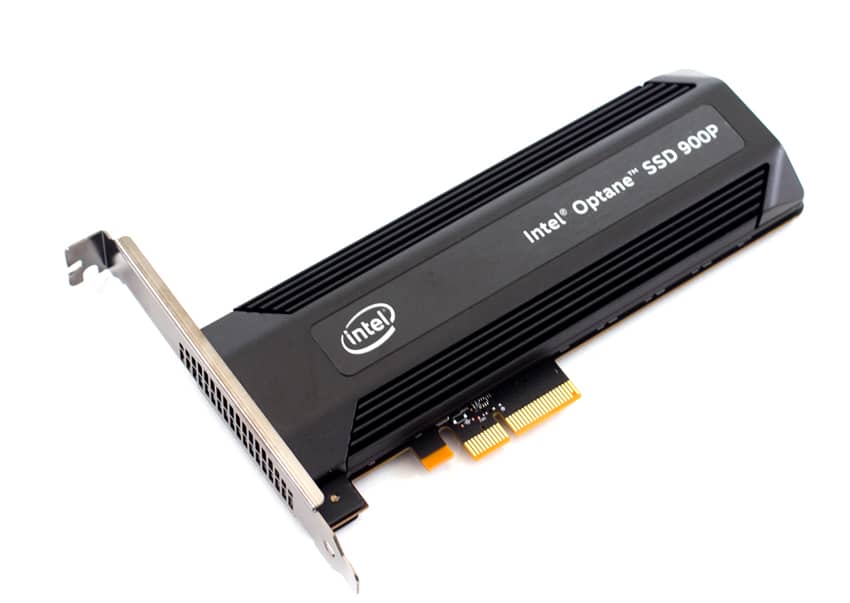
Built with Intel’s Optane non-volatile memory, the 900P was the second release that leverages this technology, sitting alongside the other Optane drives we reviewed: the 800P and the aptly named Optane Memory. Moreover, the 900P marks the highest end-user Optane SSD capacity, with up to 480GB in the edge card.
Performance-wise, the 900P is marketed as a highly responsive client storage solution. Intel quotes their Optane drive to deliver impressive performance, up to 550,000 IOPS and 500,000 IOP in 4K random reads and writes, respectively, as well as ultra-low latency under 10ms.
Backed by a 5-year warranty, the Optane 900P comes in capacities of 280GB and 480GB. In this review, we will be looking at both the 240GB and 480GB capacities.
Intel Optane SSD 900P Series Specifications
| Form factor | Half Height Half Length (HHHL) Add-in-Card and 2.5” X 15mm, Small Form Factor U.2 |
| Capacity | Half Height Half Length (HHHL) Add-in-Card: 280GB and 480GB
2.5” X 15mm, Small Form Factor U.2: 280GB |
| Interface | PCIe 3.0 X4, NVMe |
| NAND | 3D XPoint memory media |
| Operating Temperature | 0° C to 70° C |
| Performance | |
| Sequential read | Up to 2,500MB/s |
| Sequential write | Up to 2,000MB/s |
| Random read | 550,000 IOPS |
| Random write | 500,000 IOPS |
| Endurance | |
| Life Expectancy | 1.6 million hours Mean Time Between Failures (MTBF) |
| Lifetime Endurance | 10 Drive Writes per Day (DWPD) |
| Power | |
| Active Read – Average Power | 8W |
| Active Write – Average Power | 13W |
| Warranty | 5-year |
Design and build
Our Intel Optane SSD 900P review units are of the half-height half-length add-in card (HHHL AIC) form factor. On one side, the PCB is covered by a slick looking black cover, which has Intel branding and the model name as well; it also has ventilation on the sides. This protects the drive’s components and provides ample heat shedding. Turning the drive over shows the exposed, blank circuit board.
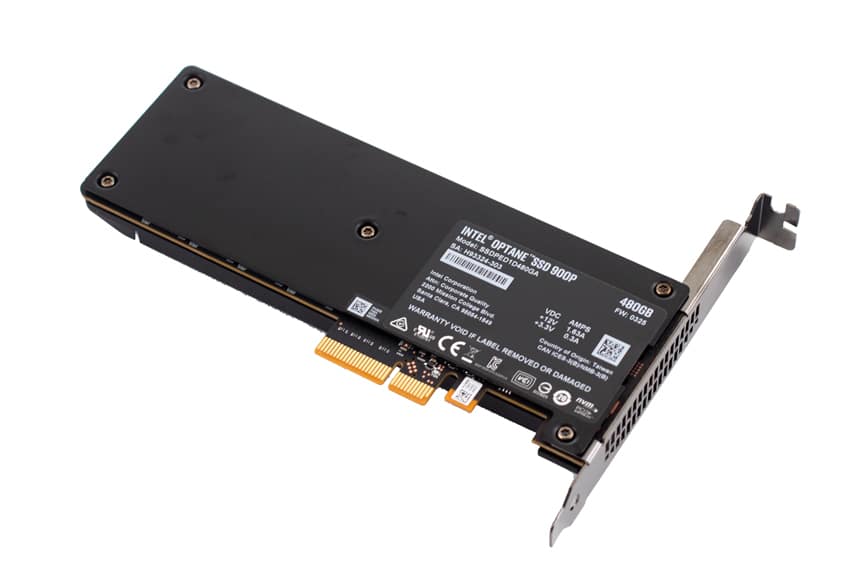
The 900P uses a PCIe Gen 3 x 4 connector and fits in full-height and half-height PCIe slots.
Performance
Testbed
The test platform leveraged in these tests is a Dell PowerEdge R740xd server. We measure SAS and SATA performance through a Dell H730P RAID card inside this server, although we set the card in HBA mode only to disable the impact of RAID card cache. NVMe is tested natively through an M.2 to PCIe adapter card. The methodology used better reflects end-user workflow with the consistency, scalability and flexibility testing within virtualized server offers. A large focus is put on drive latency across the entire load range of the drive, not just at the smallest QD1 (Queue-Depth 1) levels. We do this because many of the common consumer benchmarks don’t adequately capture end-user workload profiles. In the case of the 900P, he did not need an adaptor card due to its form factor.
Houdini by SideFX
The Houdini test is specifically designed to evaluate storage performance as it relates to CGI rendering. The test bed for this application is a variant of the core Dell PowerEdge R740xd server type we use in the lab with dual Intel 6130 CPUs and 64GB DRAM. In this case we installed Ubuntu Desktop (ubuntu-16.04.3-desktop-amd64) running bare metal. Output of the benchmark is measured in seconds to complete, with fewer being better.
The Maelstrom demo represents a section of the rendering pipeline that highlights the performance capabilities of storage by demonstrating its ability to effectively use the swap file as a form of extended memory. The test does not write out the result data or process the points in order to isolate the wall-time effect of the latency impact to the underlying storage component. The test itself is composed of five phases, three of which we run as part of the benchmark, which are as follows:
- Loads packed points from disk. This is the time to read from disk. This is single threaded, which may limit overall throughput.
- Unpacks the points into a single flat array in order to allow them to be processed. If the points do not have dependency on other points, the working set could be adjusted to stay in-core. This step is multi-threaded.
- (Not Run) Process the points.
- Repacks them into bucketed blocks suitable for storing back to disk. This step is multi-threaded.
- (Not Run) Write the bucketed blocks back out to disk.
In terms of performance, the entire Intel Optane family dominated the top of the chart. We’re measuring the rendering time, so less is better, and it’s clear in everything, the Optane devices easily outpace the rest of the pack. What might be most surprising, though, is even the enterprise NVMe SSDs had trouble keeping up in this test compared to the Intel Optane 800P, let alone the 480GB 900P.
SQL Server Performance
We use a lightweight virtualized SQL Server instance to appropriately represent what an application developer would use on a local workstation. The test is similar to what we run on storage arrays and enterprise drives, just scaled back to be a better approximation for behaviors employed by the end user. The workload employs the current draft of the Transaction Processing Performance Council’s Benchmark C (TPC-C), an online transaction processing benchmark that simulates the activities found in complex application environments.
The lightweight SQL Server VM is configured with three vDisks: 100GB volume for boot, a 350GB volume for the database and log files, and a 150GB volume used for the database backup we recover after each run. From a system resource perspective, we configure each VM with 16 vCPUs, 32GB of DRAM and leverage the LSI Logic SAS SCSI controller. This test uses SQL Server 2014 running on Windows Server 2012 R2 guest VMs and is stressed by Dell’s Benchmark Factory for Databases.
SQL Server Testing Configuration (per VM)
- Windows Server 2012 R2
- Storage Footprint: 600GB allocated, 500GB used
- SQL Server 2014
- Database Size: 1,500 scale
- Virtual Client Load: 15,000
- RAM Buffer: 24GB
- Test Length: 3 hours
- 2.5 hours preconditioning
- 30 minutes sample period
When looking at SQL Server Output, the Intel 900P 480GB drive recorded the best performance with 3,160 TPS.
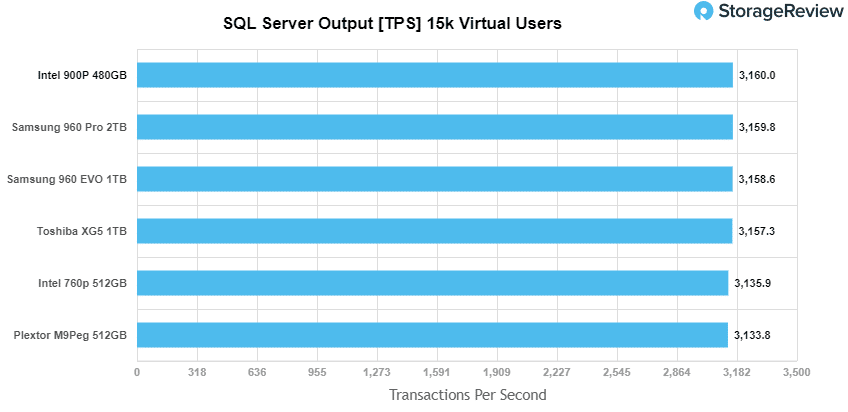
In average latency, the Intel 900P 480GB again had the top performance (tying with the Samsung 960 PRO 2TB) with an average latency of just 4.0ms.
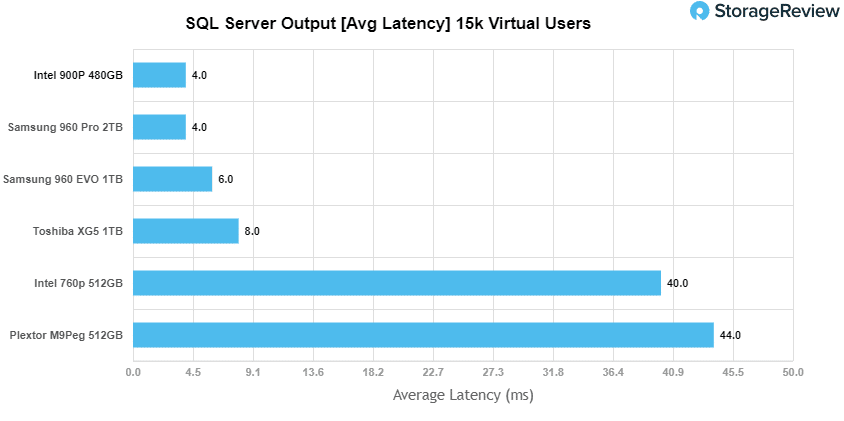
VDBench Workload Analysis
In our first VDBench Workload Analysis, we looked at random 4K read performance. Here, the Intel 900P 480GB and 280GB models were able to maintain sub-millisecond latency throughout their run, peaking at around 587,00 IOPS and 589,000 IOPS, respectively, and both hitting around 215μs. These results were far and beyond the other tested SSDs.
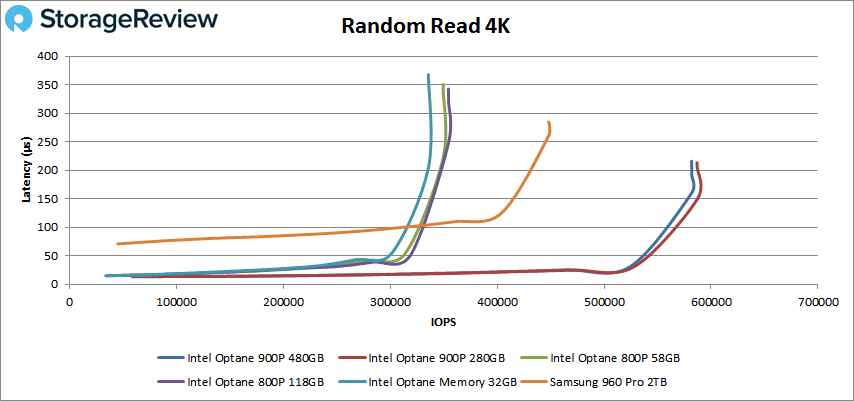
In random 4K write performance, both 900P capacities showed extremely impressive (and near identical) latency and IOPS, with a latency that was below 200μs throughout the entire test except at the very end. Peak performance measured roughly 558,000 IOPS for both.
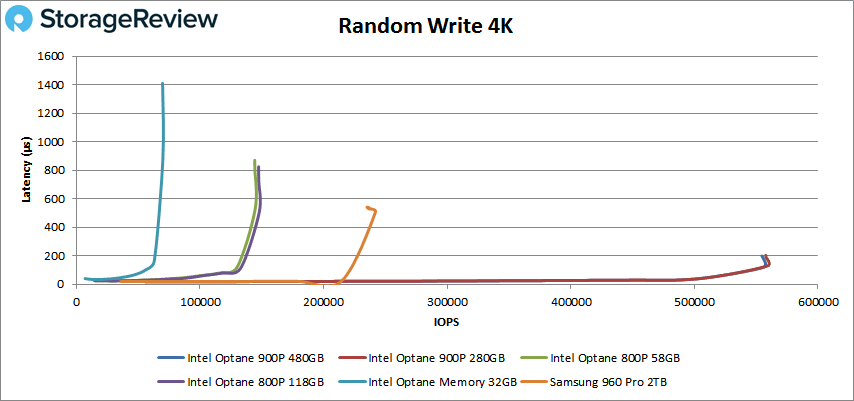
Moving to sequential performance, we looked at our 64K benchmarks. Again, both 900P capacities recorded performance well beyond the other drives. In reads, the Intel 900p maintained sub-millisecond latency throughout our test and peaked at 40,695 IOPS (2.52GB/s) and 40,757 IOPS (2.54GB/s) for the 480GB and 280GB, respectively with both under 400μs.
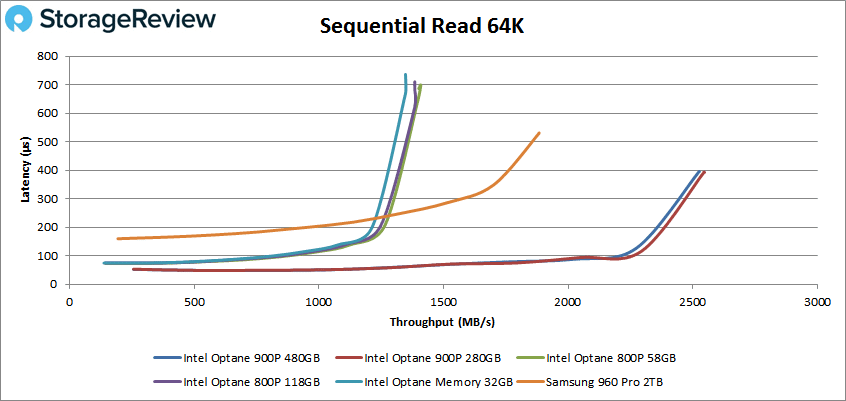
In sequential 64K write, the 480GB and 280GB Intel 900P drives showed near identical performance again, maintaining sub-millisecond latency throughout the test (and even below 500μs). Peak performance was roughly 35,000 IOPS (2.9GB/s) for both drives.
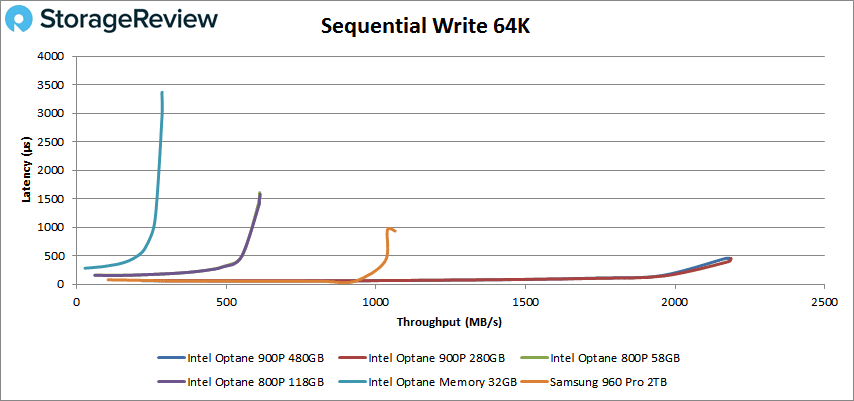
Next, we looked at our VDI benchmarks, which are designed to tax the drives even further. These tests include Boot, Initial Login, and Monday Login. Looking at the Boot test, both 900P capacity models had very impressive latency throughout the entire test, peaking around 169K IOPS. Again, the charts so significantly lower sustained latency throughout, starting as low as 28μs and staying below 200μs until the very end of the test.
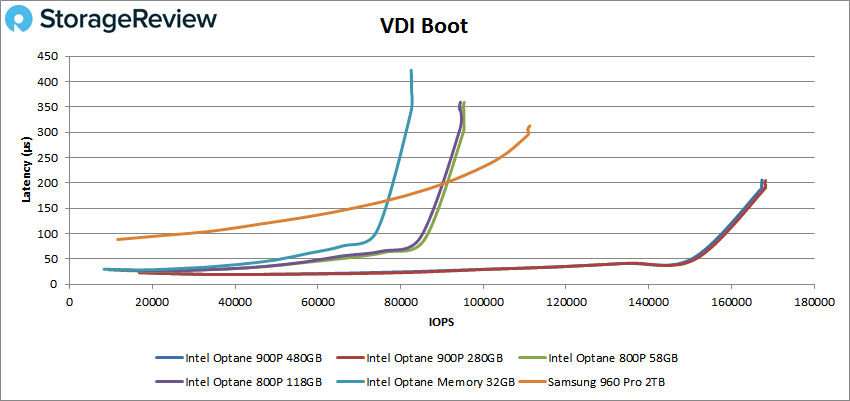
For the VDI Initial Login, the 480GB and 280GB models had identical performance with a sub-300μs latency throughout the entire test. Both drives also peaked at a 108,821 IOPS and 273μs.
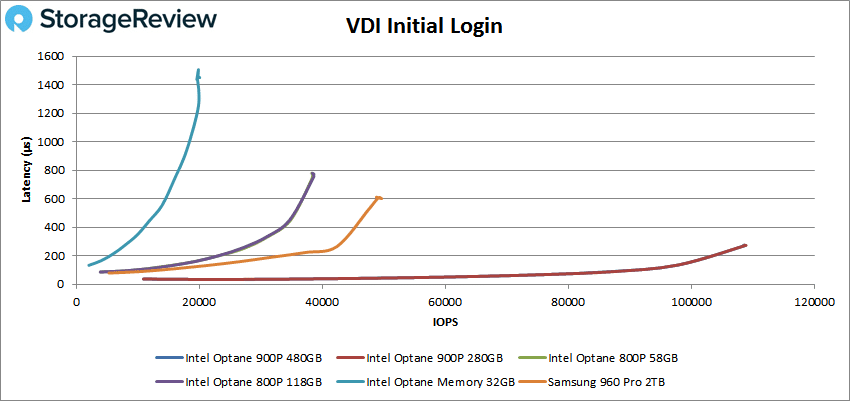
For the final VDI Monday Login, the Intel 480GB and 280GB again had sub-200μs latency performance throughout the test with identical performance once again. They both peaked at 98,000 IOPS with a latency of 161.8μs.
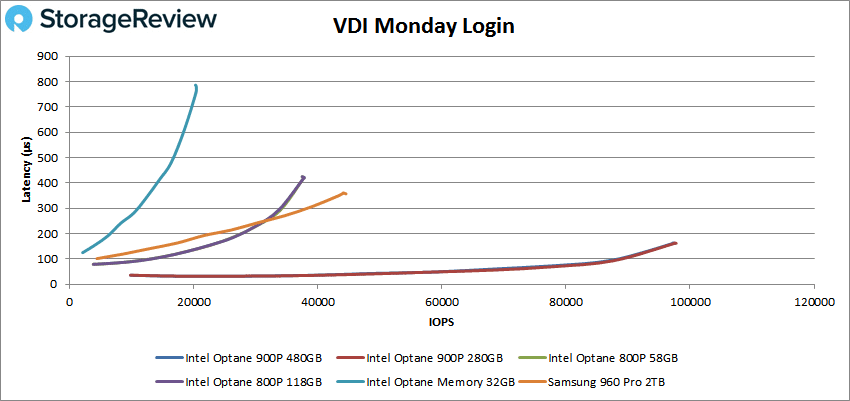
Conclusion
As clearly shown above in our performance charts, the Intel Optane 900P Series is one of the fastest drives we’ve tested to date. Intel’s use of Optane memory has produced mixed results in the other Intel drives (i.e., the 800P and Optane Memory); however, this release shows what Intel is capable of producing for professionals and enthusiasts alike. This impressive line of SSDs comes in both PCIe and 2.5” form factors and certainly has what it takes to excel in a variety of resource-intensive use cases such as engineering workloads, media creation and even gaming, for the hardcore crowd.
As for the details of its performance, the 480GB and 280GB models had almost identical performance in the majority of our tests. This is somewhat rare, as the higher capacities usually outperform smaller versions, giving customers another reason to spend the extra cash for the larger model. But for the 900P, users will be able to experience virtually the same performance no matter the capacity.
In random performance, both 900P capacities were able to maintain sub-millisecond latency throughout their run, peaking at around 587,00 IOPS (480GB) and 589,000 IOPS (280GB), and both hitting around 215μs. In writes, both capacities had extremely impressive latency and IOPS, with sub 200ms latency throughout the test and peak performance of roughly 558,000 IOPS. These results out-performed the other tested SSDs by a huge margin.
In our multi-threaded 64K sequential read benchmarks, the Intel 900P SSDs were able to easily maintain sub-millisecond performance throughout the test again while peaking at roughly 40,695 IOPS (2.52GB/s) and 40,757 IOPS (2.54GB/s) for the 480GB and 280GB, respectively. In writes, peak performance was roughly 35,000 IOPS (2.9GB/s) for both drives. Moving on to our VDI tests, the 900P continued its dominance, placing first in all of our tests (again, by a huge margin), which was comprised of the VDI Boot, Initial Login and Monday Login benchmarks.
Most impressive, though, is the work the 900P does in Houdini. Here the 480GB drive posts a render time of 1,540 seconds, where the 240GB drive comes in at 1,782. Both drives were only bested by Intel’s enterprise Optane drive, the P4800X, which edged in front with 1,520 seconds. More appropriately, the 480GB 900P beat the next closest end-user drive by over 19 minutes. If you work in an industry where time is money and workload is storage dependent, Intel has handed you every excuse to push the bosses (or yourself) for these latest drives.
Bottom Line
The Intel Optane 900P proves just how large an impact low-latency storage can have on the applications that can take advantage of it. The 900P is a professional’s dream, making it easily the best end-user SSD available right now.
Sign up for the StorageReview newsletter
